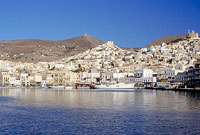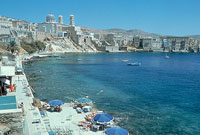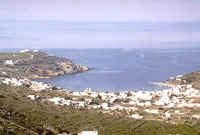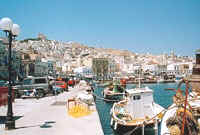 |
|
|
|
| HISTORY
The history of the island begins with the Neolithic Age. Finds at Kastri and Halandriani belong to the early Cycladic period (2700-2000 BC.) The first inhabitants were Phoenician, followed in the 10th and 9th century by Ionian colonists who found two cities, one where Ermoupolis now stands. |
|
 |
|
 |
|
Like the surrounding islands, it joined the Athenian Confederacy, and ruled by successive waves of Macedonians. Ptolemies and Romans. Undergoing a decline during the Byzantine era, it too belonged to the Duchy of Naxos until1537 when Turks overthrew the Franks. Many Catholics took refuge on the island, and with the support of Venice and France it became a bastion of Catholicism. Syros enjoyed great prosperity in the years before and after the Revolution. |
|
| SIGHTSEEING
The capital, built in 1822, impresses the visitor with its old mansions and distinctive local architecture. The Public Theatre is a copy in miniature of Milan's La Scala. On view in the museum are several noteworthy finds. Ano Syros, the capital under the Franks, has kept its medieval character virtually intact. |
|
 |
|
 |
|
At Halandriani, a prehistoric cemetery was discovered, while Kastri there are remains of a fortified settlement, among the oldest in the Cyclades. Medieval monuments and Byzantine churches abound in Syros, e.g. the Capuchin and Jesuit monastery, the church of Agios Yeorgios, the Faneromeni monastery. But there are also quaint villages and glorious beaches well worth exploring, as at Vari, Poseidonia, Galissa, etc. |
|
 |
|
|
|